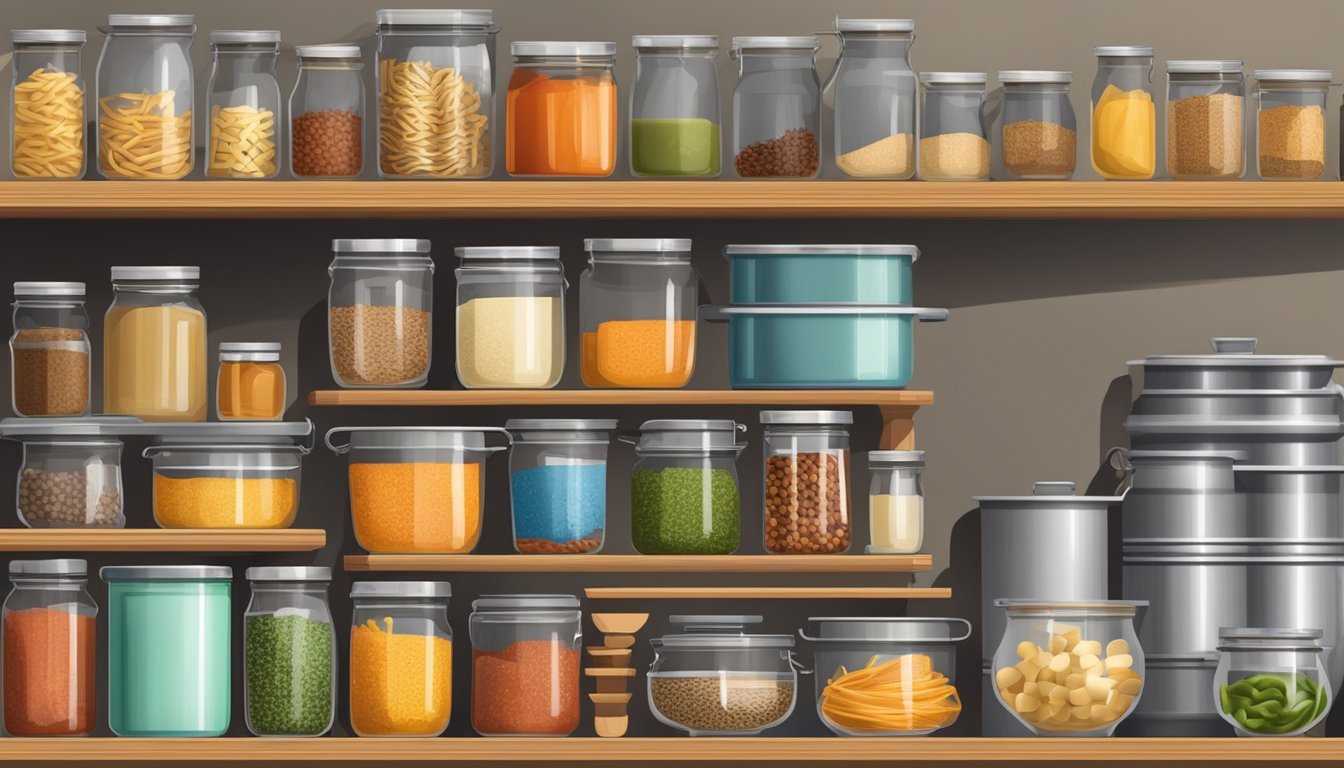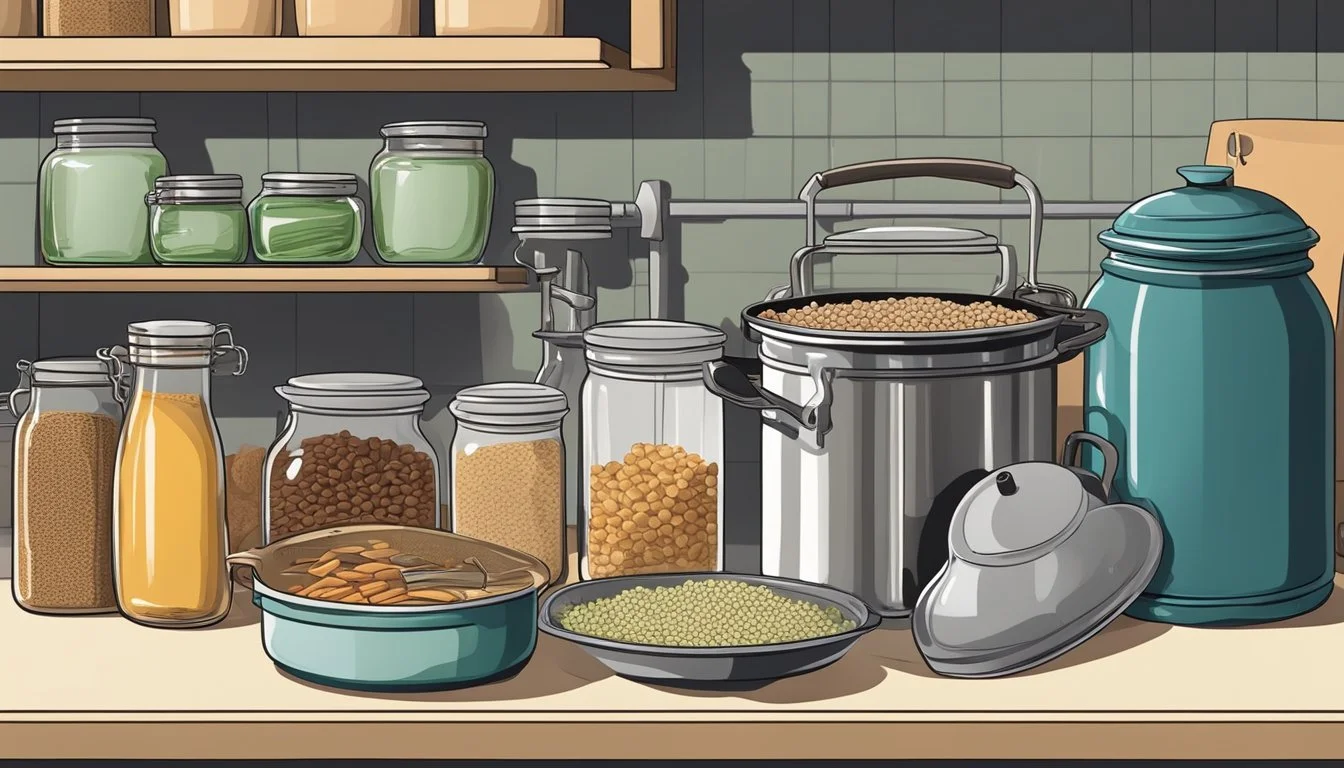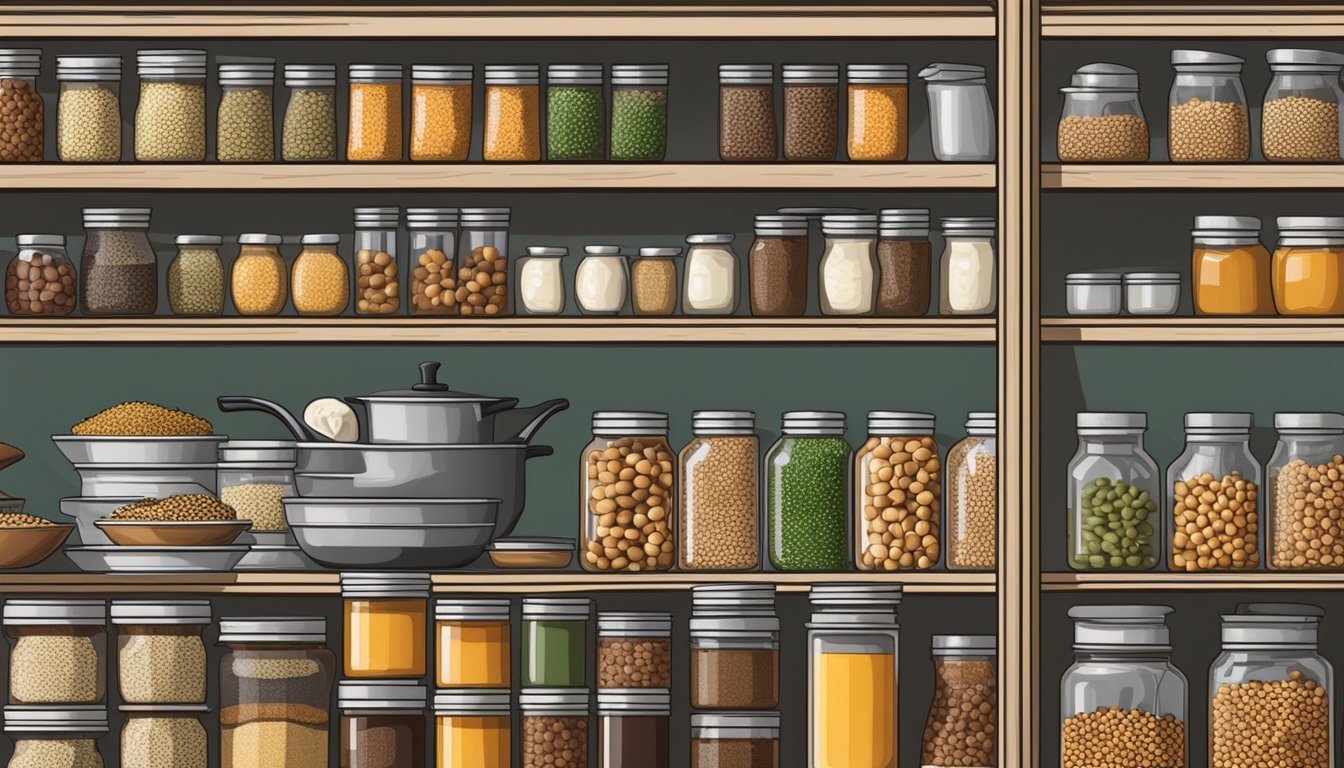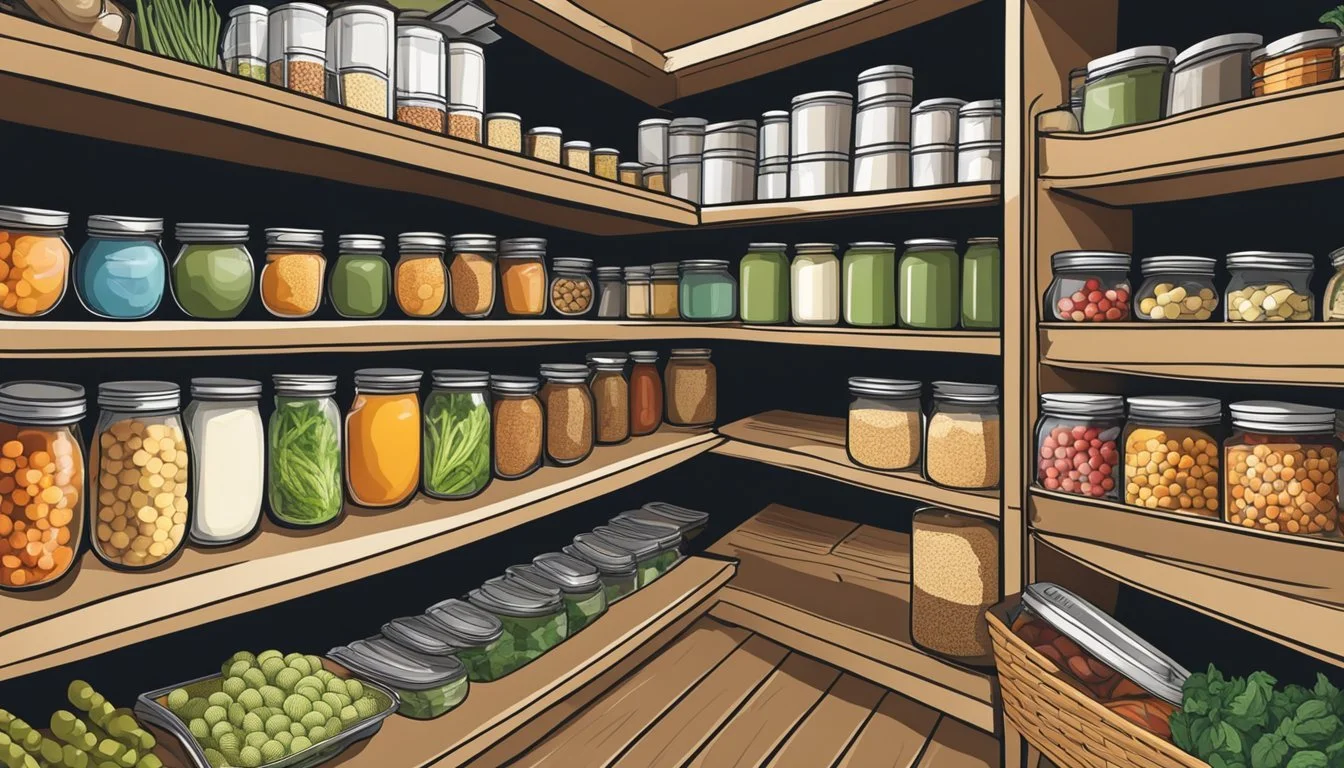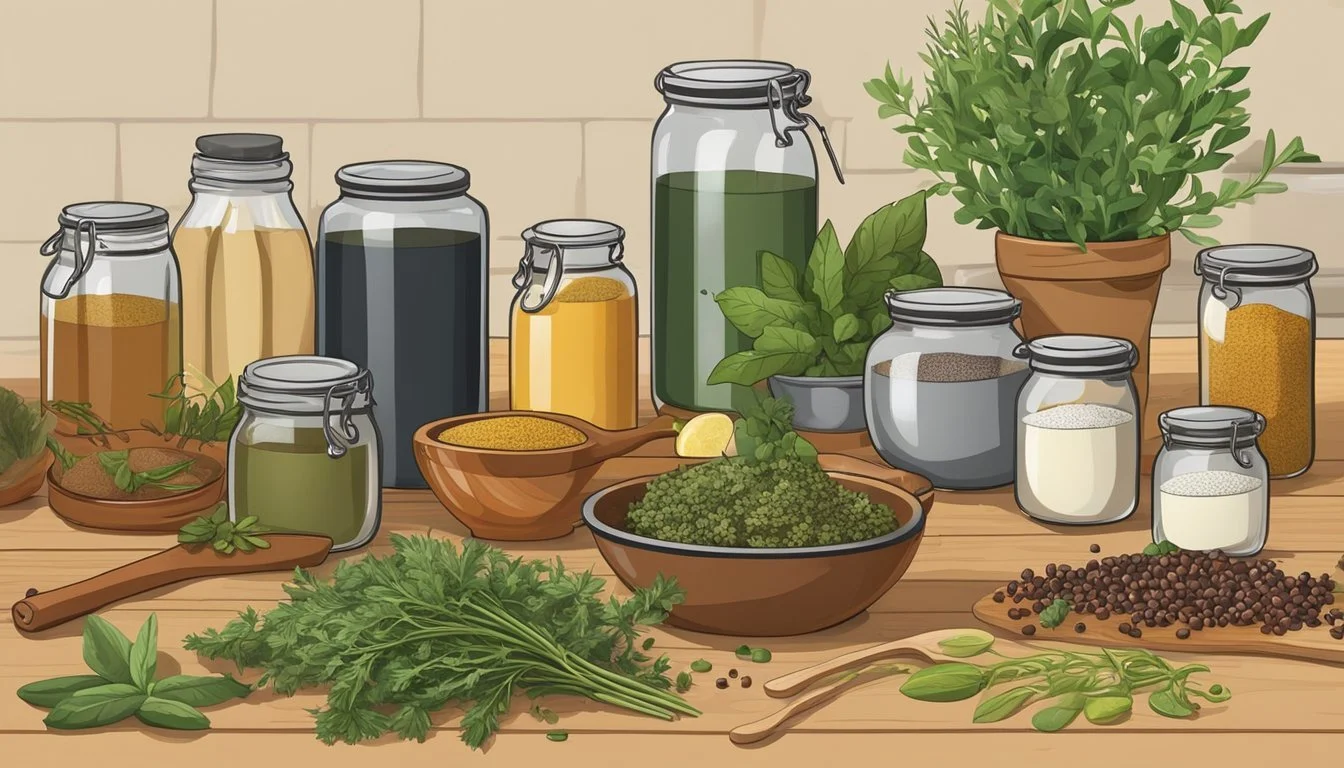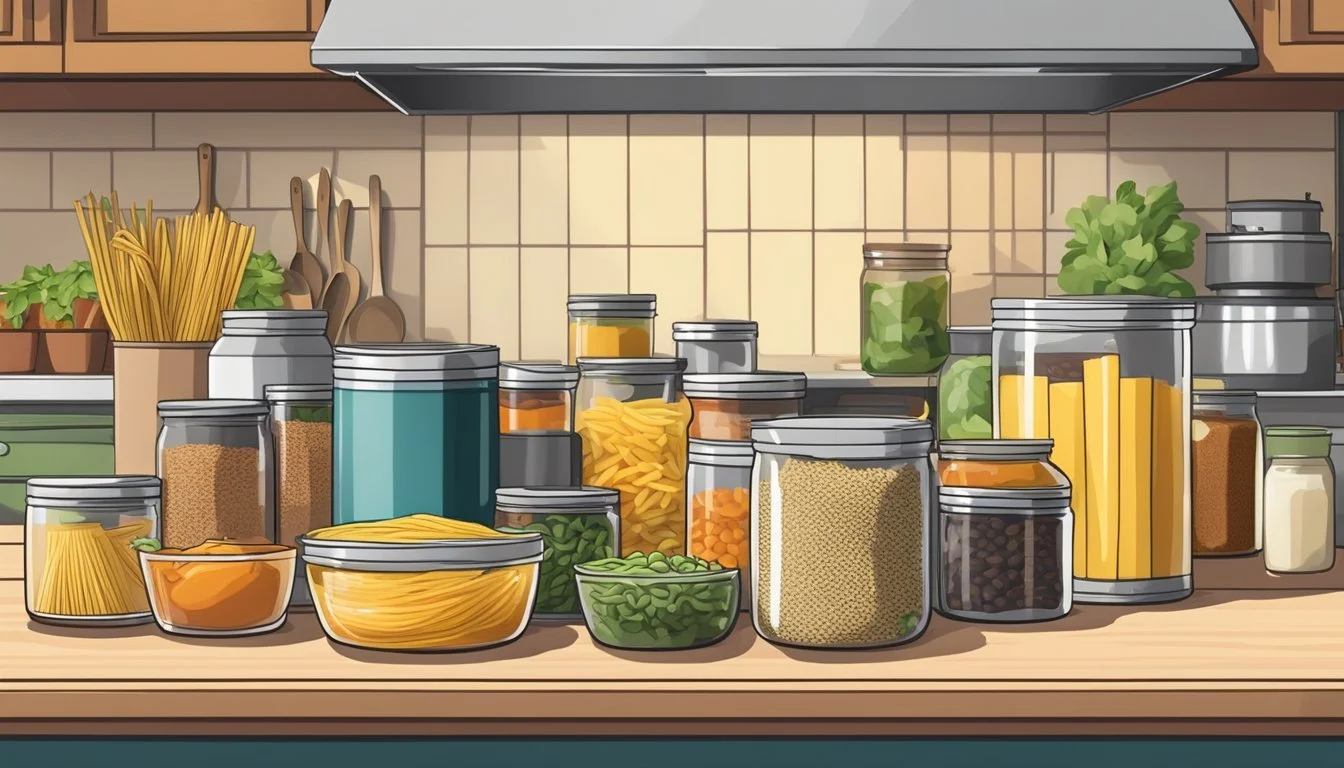How to Cook When You're Using Only Pantry Staples
Simple, Satisfying Meals
Cooking with pantry staples is an indispensable skill, especially when access to fresh produce is limited or when time and budget constraints make grocery shopping a challenge. A well-stocked pantry can be the backbone of nutritious and satisfying meals, utilizing items like canned goods, dried grains, and spices that have a long shelf life. With the right recipes and a bit of culinary creativity, these ordinary staples can be transformed into extraordinary meals.
The key to success with pantry cooking is recognizing the potential of each ingredient. Beans, lentils, and chickpeas offer a wealth of protein and can be used to bulk up soups, create hearty stews (What wine goes well with stews?), or blend into spreads like hummus. Grains such as rice, pasta, and quinoa serve as the foundation for a variety of dishes, from risottos to cold salads. With a collection of spices and condiments on hand, one can infuse these simple ingredients with flavors from around the globe.
This approach to cooking not only tests one's ingenuity but also ensures that no ingredient goes to waste. By mastering the art of cooking with pantry staples, home cooks can prepare a diverse range of meals without the need for frequent trips to the store. The resulting recipes prove that limitations in ingredients do not have to lead to a compromise in taste or nutrition.
Understanding Pantry Staples
Pantry staples are the backbone of home cooking, providing a reliable base for a wide array of meals. They are ingredients that have a long shelf life and are used in a variety of culinary applications.
Defining Staples
Pantry staples are those items that can be stored for extended periods and include a range of essential grocery products. These staples typically consist of:
Grains: such as rice, pasta, and other grains which serve as the foundation for many dishes.
Oils: with olive oil being a versatile and commonly used choice due to its flavor profile and health benefits.
Canned goods: including vegetables, fruits, beans, and meats that can be utilized in a pinch or to enhance a dish.
The pantry should be stocked primarily with food that acts as the starting point or enhancer of a meal, ensuring one can cook even without fresh produce.
Benefits of Pantry Staples
The benefits of maintaining a well-stocked pantry with staples include:
Cost-effectiveness: Bulk buying and fewer shopping trips create potential savings.
Time efficiency: Having the basics at hand reduces preparation time.
Versatility: Staples like rice and pasta can be used in numerous recipes, from stir-fries to soups.
These ingredients are not only about convenience but also about enabling creativity in the kitchen by using what is readily available to whip up an array of dishes.
Stocking the Pantry
A well-stocked pantry is the foundation of cooking with essentials. Carefully selected ingredients, an organized space, and consideration of shelf life ensure a pantry ready for any recipe.
Choosing the Right Ingredients
When selecting pantry staples, focus on versatility and frequency of use. Oils such as olive and canola are indispensable for cooking methods ranging from sautéing to baking. A variety of condiments, including soy sauce and Worcestershire sauce, can provide a base for numerous sauces and seasonings. Essential spices might include sea salt and steak seasoning, alongside a comprehensive array of herbs and spices to add depth to dishes.
Flour and sugars (confectioner's, granulated, light and dark brown) are basic ingredients for an array of recipes, while baking soda and pure vanilla extract expand one's baking capabilities. Stocking high-use, non-perishable items which can be used across various cuisines is key.
Organizing Your Pantry Space
An organized pantry ensures that ingredients are easy to find and use. Start by clearing the pantry and assessing what to keep. Ingredients should be visible and reachable, with frequently used items like oils and spices at the front. Use clear jars and containers with labels for bulk items such as flour, sugar, and salt. Here is how one might organize the space:
Top Shelf: Less frequently used items
Middle Shelves: Daily staples like oils, spices, and condiments
Bottom Shelf: Heavy or bulk items
Rotation is critical; place newer items behind older ones to maintain freshness.
Shelf Life Considerations
Understanding the shelf life of pantry items is crucial to avoid waste and cooking with spoiled ingredients. Regularly check dates and quality – if something hasn’t been used in a long time and doesn’t look, smell, or taste as it should, it’s best to discard it. Most oils have a shelf life of around one year, while dry spices can last up to four years if stored properly. Sugars and salts have an indefinite shelf life if kept dry and uncontaminated.
Ingredient Shelf Life Oils (e.g., olive, canola) 1 year Vinegars (e.g., white) 2 years Flour 6-8 months Sugars Indefinite
Investing in high-quality, airtight containers can extend the shelf life of these pantry staples.
Pantry-Based Meal Planning
A well-thought-out pantry-based meal plan maximizes the use of available ingredients while still allowing for a variety of tastes and easy recipes that provide comfort. Efficiency in planning leads to satisfying meals even with limited fresh produce.
Developing a Meal Plan
When one begins to develop a meal plan around pantry staples, they should first take inventory of their available ingredients. A table format helps keep track of what's on hand, the quantities, and possible pairings.
Inventory Example:
Ingredient Quantity Possible Uses Canned chickpeas 3 cans Salads, Hummus, Stews Rice 2 lbs Stir-fries, Puddings, Side dishes Pasta 1 lb Casseroles, Pasta salads, Soups
After inventory, one should categorize the staples into core groups, such as proteins, grains, and seasonings. Then, identify which items can be bases for meals and which can be used to enhance flavors and add variety. Individuals should aim for a balance of nutrients while also considering preparation time to ensure meals are easy to make.
They might construct a weekly plan, using themes to guide recipe choice, for example, 'Meatless Monday' or 'Soup Sunday'. This structure aids in creating a diverse menu, preventing meal fatigue, and maintaining excitement for comfort foods that please the palate.
Recipe Adaptation
Not every recipe will be possible to make when only pantry items are available, but one has the freedom to adapt recipes to fit their ingredients. Creativity in the kitchen means substituting or leaving out non-essential items.
Substitution Suggestions:
For fresh herbs: Use dried herbs, but reduce the amount by half, as dried are more potent.
For meats: Beans or lentils can be a hearty protein replacement.
For vegetables: Canned or frozen options may work, keeping in mind the textural differences.
One can deconstruct complex recipes into simpler versions that focus on the essence of the dish by highlighting the key flavors or components. For instance, a traditional lasagna could be transformed into a simple pasta bake with tomato sauce and whichever cheeses are available.
Throughout the adaptation process, the focus remains on maintaining the taste profile of the original dish while making the best use of pantry staples. Attention to seasoning is key—it can turn basic ingredients into comfort food that is both satisfying and reminiscent of more elaborate recipes.
Recipes for Breakfast
Creating delicious breakfast dishes using pantry staples doesn't have to be daunting. With a focus on oats and grains and baking essentials, anyone can whip up a satisfying morning meal.
Oats and Grains
Oats provide a versatile base for a variety of breakfast options. They can be used to make a simple bowl of oatmeal, or they can form the foundation of more complex dishes like pancakes or waffles. For something straightforward yet nutritious, one can prepare a classic oatmeal by boiling oats in water or milk and sweetening it with honey, maple syrup, or sugar from the pantry. Customizing it with cinnamon, nuts, or dried fruits (What wine goes well with dried fruits?) can add flavor and texture.
Baked Oatmeal: Preparing baked oatmeal the night before allows for a quick and easy breakfast. Simply mix oats with a choice of milk, an egg for binding (if available), and preferred spices. One can include canned or dried fruits for added sweetness.
Pancakes or Waffles: Utilizing a basic recipe of flour, baking powder (as a leavening agent instead of yeast), a bit of sugar, and water or milk can result in fluffy pancakes or waffles. These can be enhanced with oats mixed into the batter for added fiber.
Baking with Pantry Staples
Baking can be somewhat more challenging without fresh produce, but with the right pantry staples, one can still produce delightful breakfast baked goods.
Pantry Muffins: By starting with flour and sugar, and using baking powder or soda, a simple muffin batter can be made. It allows for a variety of mix-ins like dried fruits, nuts, or chocolate chips.
Scones or Biscuits: With just flour, a leavening agent like baking powder, and shortening or oil, one can craft a dough for scones or biscuits. These can be made sweet with sugar and dried fruit, or savory with herbs and spices.
Each recipe presents an opportunity for personalization based on what's available in the pantry. These approaches to breakfast utilize simple ingredients to create fulfilling and tasty meals to start the day.
Creating Substantial Mains
Creating substantial mains with pantry staples is all about making the most of protein-rich ingredients and versatile grains to ensure satiety and nutrition.
Hearty Pasta and Rice Dishes
Successful pantry cooking often hinges on a solid foundation of pasta and rice, which can be combined with a variety of proteins and vegetables to create fulfilling meals. For example, one can transform plain rice into a Rainbow Rice dish by incorporating canned or frozen vegetables, and adding canned meat or beans for protein. Likewise, a simple pasta can be elevated by mixing in canned chicken and vegetables, finished with a sprinkle of herbs.
Recipe Main Ingredient Protein Source Suggested Additions Rainbow Rice Rice Canned meat, Beans Canned/Frozen Vegetables Chicken Pasta Toss Pasta Canned Chicken Olives, Sun-Dried Tomatoes, Herbs
Utilizing Beans and Lentils
Beans and lentils are incredibly nutritious and serve as a cost-effective protein option. A classic Cannelini and Cherry Tomato Salad is an example of a light yet protein-rich meal that can be prepared quickly. Hearty dishes like Smoky White Bean Shakshuka or a Mole-Spiced Black Bean and Quinoa Bowl combine the richness of beans with spices to create a satisfying main course.
Canned Chickpeas: Toss chickpeas in soups, stews, or make them into a spread such as hummus.
Lentils: Perfect for adding to salads or serving as a bed for meats, they cook quickly and are packed with protein.
By focusing on these adaptable ingredients, one can create an array of satisfying mains that will support a well-rounded diet using pantry staples.
Incorporating Proteins
When cooking with pantry staples, one's ability to include sufficient protein in meals is key to maintaining a balanced diet. A well-stocked pantry should include a variety of protein-rich options, ranging from canned meats to legumes.
Canned and Dried Meat Options
Canned meats such as chicken, tuna, and beef are excellent, shelf-stable sources of protein that can be added to an array of dishes. They provide convenience and cut down on cooking time.
Chicken: Canned chicken can be used for quick salads or mixed with mayonnaise and spices for a simple chicken salad.
Tuna: Ideal for sandwiches, pasta dishes, or as a salad topping. It's a lean protein that's rich in omega-3 fatty acids.
Beef: Dried or canned beef can add robust flavor to stews and soups.
When using these products, ensure they are drained and rinsed if needed, to reduce excess sodium.
Vegetarian Protein Sources
Beans and chickpeas are vegetarian pantry essentials, packed with protein and fiber. Nuts are also a nutritious protein option for snacking or incorporating into meals.
Beans: Available in dried and canned varieties, beans can be the foundation for soups, stews, and even make a simple bean salad.
Chickpeas: Apart from being an excellent addition to curries and salads, chickpeas can be roasted for a crunchy snack or ground to make hummus.
Nuts: A handful of nuts can provide a quick protein boost and can also be added to oats or yogurt for breakfast.
Using these vegetarian sources, one can create filling and protein-rich meals even with a limited fresh food supply.
Versatile Vegetable Dishes
Creating versatile vegetable dishes with pantry staples is both economical and nutritious. By maximizing the use of frozen and canned vegetables and employing a variety of seasonings, one can prepare satisfying meals that are both flavorful and convenient.
Maximizing Frozen and Canned Veggies
Utilizing frozen vegetables such as spinach, kale, and carrots allows for both variety and longevity in one's cooking repertoire. These vegetables retain much of their nutritional value and can be a great addition to many dishes. For example, frozen kale can be easily added to soups or stews, while carrots can be incorporated into a stir-fry or blended into a smooth soup.
Spinach: Ideal for omelets, quiches, and as a simple sautéed side.
Carrots: A sweet and crunchy addition to salads, casseroles, or as a roasted side.
Canned vegetables are also incredibly versatile and have an extended shelf life. They can be used straight from the can or enhanced with further cooking.
Flavorful Combinations and Seasonings
To elevate the taste of pantry-based vegetable dishes, one should consider a variety of seasonings and flavor combinations. Ginger, for instance, pairs well with just about any vegetable, offering a warm, spicy kick that can transform a dish.
Ginger: Great with sautéed greens or in a vegetable stir-fry.
Below is a table showcasing simple seasonings that can be paired with specific vegetables for enhanced flavor:
Vegetable Seasoning Suggestion Spinach Garlic, nutmeg, lemon juice Kale Red pepper flakes, garlic Carrots Cumin, cinnamon, maple syrup
Experimenting with different herbs and spices can lead to delicious discoveries and make the most out of any vegetable dish.
Flavoring with Herbs and Spices
A well-stocked pantry can be a treasure trove for flavoring dishes with herbs and spices. These ingredients add character to even the most basic pantry staples. Understanding how to create robust flavor profiles and considering herbs and spices as pantry essentials are key to elevating home cooking.
Creating a Flavor Profile
When cooking from the pantry, one can create vibrant flavor profiles by thoughtfully pairing herbs and spices with staple ingredients. Garlic and pepper serve as foundational flavors; they can be used to craft a simple yet impactful base for a variety of dishes. To add complexity, one might incorporate capers (What wine goes well with capers?) or olives, which introduce a briny, acidic note that pairs well with starches like pasta or rice.
Creating Flavor Combinations:
Bold: Garlic, cayenne pepper, smoked paprika — great for chili or stews.
Earthy: Thyme, rosemary, black pepper — complements root vegetables and legumes.
Fresh: Basil, parsley, lemon zest — perfect in salads or sprinkled over pasta.
By selecting the right combination of herbs and spices, a cook can transform the ordinary into the sublime, inviting the palate on a journey from the familiar to the extraordinary.
Herbs and Spices as Staples
Herbs and spices should occupy a central place in any pantry. Dried herbs and ground spices maintain potency over time, making them ideal for long-term storage. To ensure they impart the most flavor, these staples should be stored in a cool, dry place, away from direct sunlight.
Essential Pantry Herbs and Spices:
Herbs: Oregano, parsley, bay leaves, rosemary, thyme
Spices: Cumin, coriander, cinnamon, nutmeg, allspice
When fresh herbs are available, they can easily be preserved by freezing in ice cube trays with water for later use in cooking. Adding an herb ice cube to sauces, soups, or cooked vegetables infuses the dish with a burst of fresh flavor. Whether fresh or dried, these flavor agents are instrumental in achieving the desired taste and depth in pantry-based cooking.
One-Pot Wonders
The appeal of one-pot meals lies in their efficiency and simplicity. Utilizing just a single pot, these dishes highlight how one can create hearty meals with pantry staples, maximizing flavor while minimizing cleanup.
Instant Pot and Pressure Cooker Meals
The Instant Pot and pressure cookers have revolutionized one-pot cooking, drastically reducing cooking times for dishes that traditionally take hours. Lentil Soup, a pantry staple, transforms into a nutrient-rich meal with the combination of dried lentils, canned tomatoes, broth, and any available spices. Similarly, Beef Goulash can be prepared quickly in a pressure cooker; beef chunks, paprika, onions, and pantry-ready canned tomatoes are the core ingredients.
Key Recipes:
Lentil Soup: High pressure for 15 minutes
Beef Goulash: High pressure for 35 minutes
Stovetop Soups and Stews
For those without an Instant Pot, the stovetop is a trusty ally. Stews and soups are particularly forgiving, adaptable to various pantry staples. A simple Lentil Soup, simmered with broth, carrots, and spices, provides comfort. Beef Stew (What wine goes well with beef stew?) is another quintessential stovetop dish, where seared beef, potatoes, carrots, and a touch of flour for thickening come together as a robust meal.
Essential Components:
Lentils: the base for protein-rich soups.
Beef: a hearty addition for filling stews.
Cooking Times:
Lentil Soup: Simmer for about 30 minutes.
Beef Stew: Allow to stew for at least 1.5 hours.
Sweet Endings with Pantry Items
Crafting delightful sweets doesn't require a trip to the store when one's pantry is well-stocked. Utilizing basic ingredients like sugar and flour, one can indulge in no-bake treats or whip up simple baked goods to satisfy that sweet tooth.
No-Bake Treats
In the realm of no-bake desserts, a few staple items can yield delicious results. Utilizing ingredients typically found in a pantry, such as honey and chocolate chips, one can create treats like:
Chocolate Peanut Butter Balls: Combine equal parts peanut butter and powdered sugar with a handful of chocolate chips and a drizzle of honey. Roll into balls and chill until firm.
Classic Rice Crispies: Melt a bit of butter and marshmallows, stir in crispy rice cereal, and press into a pan. Cool and cut into squares.
One's creativity is the limit when concocting no-bake delights, as these treats often require just a handful of simple, shelf-stable ingredients.
Simple Baked Goods
For those with an oven and a few pantry items, the options for home-baked treats are truly abundant. Here are uncomplicated recipes that require little more than the essentials:
Chocolate Chip Cookies: The quintessential pantry-staple sweet, these cookies just need flour, sugar, baking soda, salt, butter, and chocolate chips. Beat sugar and butter, mix in dry ingredients, fold in chocolate chips, and bake until golden.
Banana Bread: A perfect way to use up overripe bananas, mix mashed bananas with flour, sugar, and a leavening agent. Pour into a loaf pan and bake until a toothpick comes out clean.
By keeping a pantry stocked with items like sugar and flour, simple desserts are just an impulse away. Whether it's no-bake treats when in a time crunch or comforting baked goods, pantry staples are the foundation of countless sweet recipes.
Savvy Shopping for Pantry Cooking
When stockpiling for pantry-focused meals, shoppers should prioritize products that offer versatility, longevity, and economical value. This strategy ensures a well-stocked pantry that can support diverse and nutritious meals.
Budget-Friendly Purchasing
One aims to balance cost with nutritional content when selecting pantry staples. Shoppers are advised to look for canned goods, which often boast long shelf lives and can be excellent sources of protein and fiber. Examples of canned goods to consider are chickpeas, black beans, and various types of lentils. Dried pasta is another cornerstone of a cost-effective pantry, as it is inexpensive and can be stored for extended periods. Whole grain options can provide additional health benefits.
Finding Deals on Staple Items
Identifying discounts on staple items can significantly lower grocery bills. Shoppers should keep an eye out for sales on canned soups, which can serve as a base for more complex dishes or be enjoyed as a simple meal. Utilizing coupons and buying store-brand versions of staple items can also help reduce costs without sacrificing quality. Bulk purchasing of non-perishable items like rice and pasta is wise when discounts are available, but one should only buy quantities that they can realistically use.
When it comes to pantry shopping, it's not only about what one buys, but how and when they buy it that can make all the difference.
Pantry Staple Substitutions
When certain ingredients are out of reach, knowing how to substitute pantry staples can keep cooking creative and meals flavorful. This section explores how to use what's available to replace commonly used items in recipes.
Alternative Ingredients for Common Recipes
Butter
If a recipe calls for butter, one can use margarine or oil (such as olive or vegetable) in a 1:1 ratio. For baking, apple sauce or mashed bananas serve as a healthy alternative, using half the amount of butter the recipe dictates.
Milk
When milk is needed, a mixture of water and powdered milk follows a 1:1 ratio, or use unsweetened soy or almond milk. For buttermilk, mix one tablespoon of lemon juice or white vinegar with a cup of whole milk and let it sit for five minutes.
Cheese
For meals requiring cheese, nutritional yeast can offer a cheesy flavor, especially in vegan cooking. In a pinch, one can often skip softer cheeses in recipes or replace them with different types of cheese that might be in the pantry.
Parmesan
If parmesan is unavailable, try grated asiago, romano, or dry jack cheese which provide similar salty and umami flavors to dishes.
Eggs
Instead of eggs, one could use ground flaxseed or chia seeds mixed with water (1 tablespoon seeds with 2.5 tablespoons water equals one egg), especially in baking. Mashed bananas or applesauce can also act as binding agents.
Nut Butter
In place of nut butter, one can use seed butters such as sunflower seed butter or even tahini. These alternatives provide similar texture and some of the flavors associated with nut butters.
Creative Swaps for Missing Staples
Resourcefulness in the kitchen means turning to creative alternations when staples like eggs, cheese, or butter are unavailable.
For baking recipes requiring eggs, a combination of vinegar and baking powder can provide leavening. Cheese can often be omitted from recipes or replaced with a different cultured dairy product like yogurt or cottage cheese (how long does cottage cheese last?), while missing butter in savory dishes can be substituted with bacon fat or lard for richness.
In place of parmesan, aged cheeses (What wine goes well with aged cheeses?) offer the desired depth, while nut butter can often be exchanged for creamy ingredients like avocado or greek yogurt in smoothies or dressings, maintaining the richness without compromising taste.
Advanced Techniques with Staple Ingredients
When cooking with pantry staples, one can employ advanced techniques to extract maximum flavor and transform basic items into gourmet dishes. This section covers how to elevate simple ingredients into exciting meals and discusses culinary techniques that add depth and complexity to flavors.
Elevating Simple Ingredients
Using staple ingredients like tomato paste or soy sauce can profoundly transform a dish. Tomato paste, when caramelized on low heat before adding other ingredients, deepens the umami flavor in marinara sauce and stews. Similarly, soy sauce can be reduced to concentrate its flavor, providing a robust foundation for dressings or marinades.
Tomato Paste: Sauté until a rust-like color is achieved for a richer base.
Soy Sauce: Reduce to a glaze-like consistency for intensified taste.
Polenta serves as a versatile canvas for flavors, absorbing surrounding ingredients to create a comforting dish. Cook it with chicken or vegetable stock instead of water, then finish with grated Parmesan cheese for a creamy and savory side dish.
Culinary Techniques for Depth of Flavor
The subtleties in flavor can be enhanced through techniques such as toasting and layering. Toasting grains like rice or couscous (What wine goes well with couscous?) in oil before boiling can unlock nutty dimensions that elevate the base flavor.
Toast grains before boiling to bring out a nuttier, deeper taste.
Creating a well-executed hummus relies on both the blend of ingredients and the technique applied. Blending the tahini with lemon juice before adding chickpeas can make the hummus creamier and balance the acidity perfectly.
Hummus: Emulsify tahini with lemon juice for creaminess and balance.
Experimenting with marinades for an extended period allows staples like soy sauce and tomato paste to infuse proteins with complex flavors.
Marinades: Combine soy sauce with tomato paste and herbs for a flavorful protein infusion.

